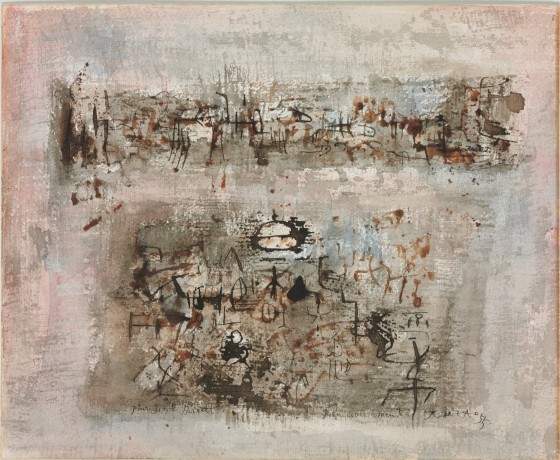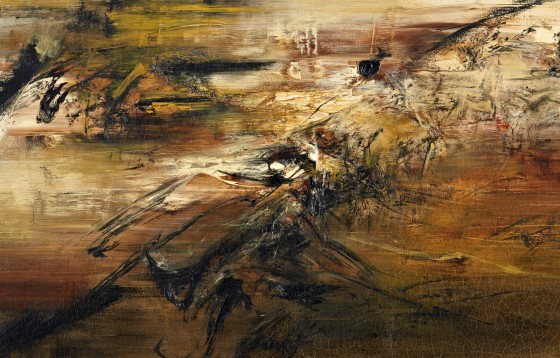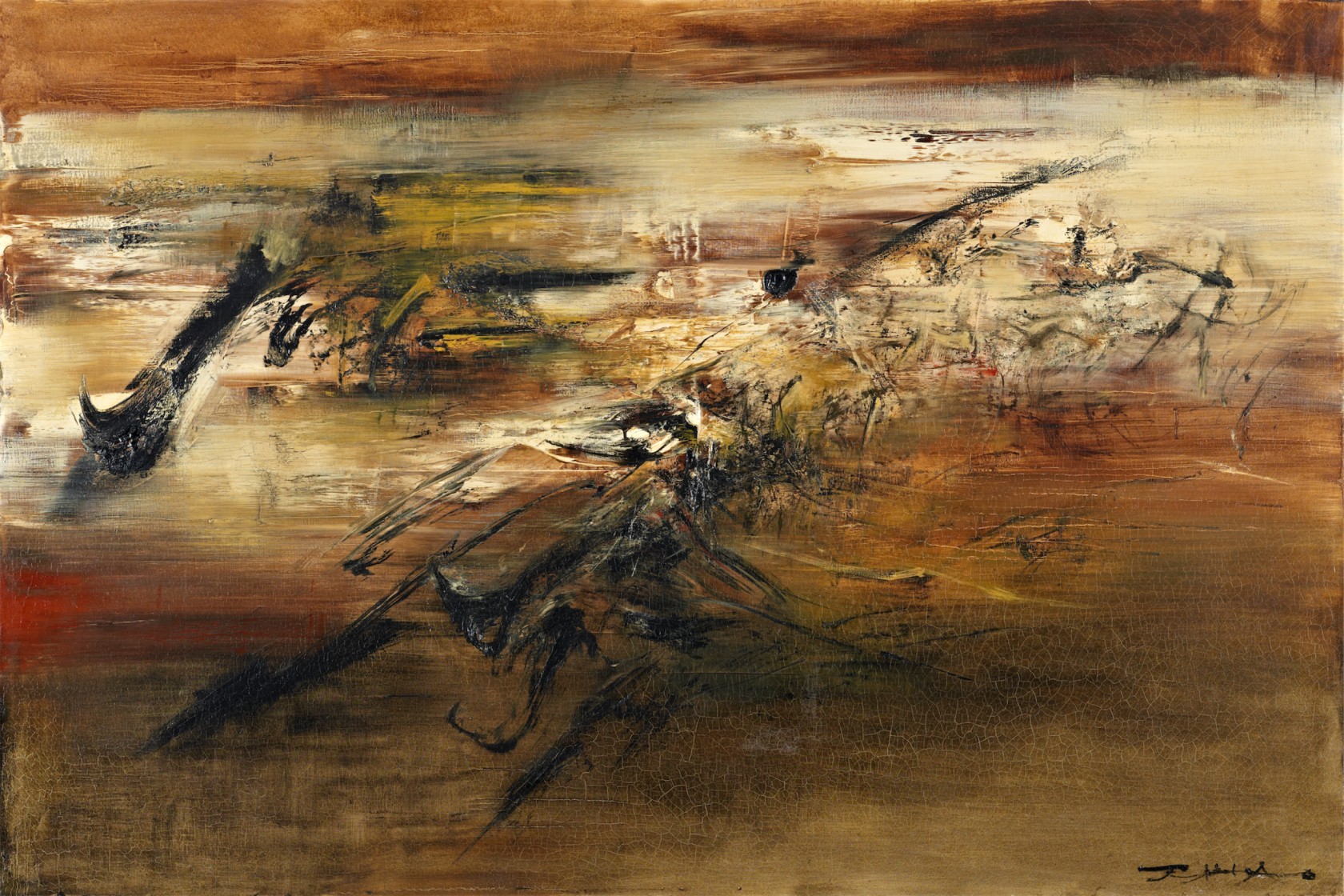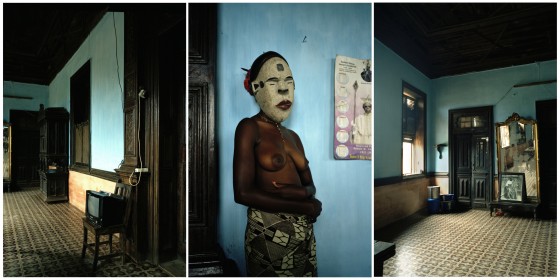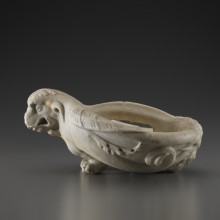
October 2023 Fine Arts
30.10.61, the fusion between nature and painting in the work
of Zao Wou-Ki
A major figure of French painting in the second half of the 20th century, Zao Wou-Ki is renowned for his large abstract and lyrical canvases. Over the course of his career, he developed a personal and poetic work, where the fundamentals of Chinese painting may be seen, as evidenced in the painting 30.10.61.
See the artwork in the collectionZAO Wou-Ki (Beijing [CN], 1920 — Nyon [CH], 2013)
30.10.61
30 October 1961
Oil on canvas
130.5 x 195.8 cm
FGA-BA-ZAO-0002
Provenance
Kootz Gallery, New York
Abraham M. and Belle Lindenbaum Collection, Brooklyn, 1961
Christie’s, London, 8 February 2007, lot no. 43
Exhibitions
Salon de mai au Japon, Tokyo, Mainichi Journal, 1962
Zao Wou-Ki. Recent paintings, New York, Kootz Gallery, 03 – 31.10.1961
XVIII Salon de Mai, Paris, Musée d’Art moderne de la Ville de Paris, 06 – 27.05.1962, no. 168
Zao Wou-Ki, Cambridge (USA), Hayden Gallery, Massachusetts Institute of Technology, 05 – 06.1964
Le grand geste! Informel und Abstrakter Expressionismus 1946-1964, Düsseldorf, Kunstpalast, 10.04 — 01.08.2010
Les Sujets de l’abstraction. Peinture non-figurative de la seconde école de Paris, 1946-1962. 101 Chefs-d’œuvre de la Fondation Gandur pour l’Art, Geneva, Musée Rath, 06.05 – 14.08.2011; Montpellier, Musée Fabre, 03.12.2011 — 18.03.2012
Zao Wou-Ki, Martigny, Fondation Pierre Gianadda, 04.12.2015 — 12.06.2016!
París pese a todo. Artistas extranjeros, 1944-1968, Madrid, Museo Nacional Centro de Arte Reina Sofía, 21.11.2018 — 22.04.2019
Éloge de l'abstraction. Les peintres de l'Académie des beaux-arts dans les collections de la Fondation Gandur pour l’Art, Paris, Palais de l'Institut de France, Pavillon Comtesse de Caen, 12.10.2023 — 26.11.2023

Between East and West
Born in Beijing in 1921 into a wealthy intellectual family, Zao Wou-Ki drew and painted from the age of ten. At the age of fourteen, he entered the Hangzhou Academy of Fine Arts, where he studied traditional Chinese and Western painting for six years. Forced to continue his studies while fleeing the Sino-Japanese conflict, he was fascinated by the grandiose landscapes of the regions he discovered during this period of exile. His interest quickly shifted to Western painting through reproductions of Cézanne, Picasso, and Matisse, which he discovered in 1940 thanks to postcards from Paris brought back by his uncle and works published in Western magazines. After the war, he returned to Hangzhou to teach at his school, but rapidly the desire to discover the French capital became a necessity: “my ambition was to go to Paris to know painting better and to study it.”1 “There was no other solution than to leave. I wanted to paint differently. I was convinced that here, that wasn’t possible.”2 According to Zao Wou-Ki, Chinese art had become “an ensemble of manufacturing recipes, where beauty was confused with expertise. Hand gestures and brush movements had become codified. There was no more room for the imagination and the unexpected.”3 In order to free himself from these shackles, he left China in 1948 and arrived in Paris the same year. He studied the French language at the Alliance Française and attended the Académie de la Grande Chaumière. He wanted to see and visit everything, in Paris and in regional France, as in Europe, in order to immerse himself in abstract painting. This period was conducive to a whole host of encounters. He made the acquaintance of Abstract artists who would have a considerable influence on his work, including Pierre Soulages, Jean Paul Riopelle, Hans Hartung, Nicolas de Staël, Maria Vieira da Silva, and Henri Michaux. Figuration definitively gave way to Abstraction after the discovery of two key painters. Firstly Cézanne, with his art of structuring the landscape and modulating the light, and secondly, Paul Klee, himself inspired by Chinese art for its use of the sign and its way of ‘understanding’ nature other than in an academic fashion”4.
Up until 1954, his paintings represented the cities and landscapes he had seen during his travels across Europe. During this period, he learned to transform the elements of nature into signs, while banishing any reference to reality from his work. He then turned towards a synthesis between oriental calligraphy and European Art Informel. The transition to Abstraction liberated his compositions. His second period, dating from 1954 to 1963, gradually culminated in the pure sign, as in the painting 30.10.61, executed in 1961. “If the influence of Paris is undeniable in my training as an artist, I also want to say that I have gradually rediscovered China, as the deepest essence of my personality asserted itself. In my recent paintings, this is expressed in an innate way. Paradoxically, it is to Paris that I owe this return to my true origins,”5 he confided in 1961. “I have tried to make it understood that tradition should not be renounced as I myself once did, but that it is a starting element for a painter's work and not an end in itself.”6 When Zao Wou-Ki spent several months in the United States, 7 he met with numerous Abstract Expressionists, who would have a considerable impact on his research in the 1960s. In November 1958, he signed a contract with the Kootz Gallery.8 Its founder, Samuel Kootz, responding to his customers’ expectations, encouraged the artist to explore the possibilities offered by the large format. Back in Paris, in 1959, he bought a larger studio on the rue Jonquoy, south of Montparnasse, where he could paint imposing canvases. Seeking to push the limits of the frame, he “experience[d] great physical joy in coating very large surfaces, to the point of becoming obsessed with it and doing nothing but that!”9 Zao Wou-Ki also confided to Jean-Jacques Levêque: “I like people to walk through my paintings just as I walk through them while making them.”10.
From Chinese calligraphy to signs
“I learned to read and write words at the same time as I learned to draw signs.”11 This is how Zao Wou-Ki describes his learning of calligraphy from the age of six onwards from his grandfather.12 “Learning writing and calligraphy can only be done through the repetition of the gesture. All academicism comes from repetition. Painting is precisely the art of avoiding this trap. It took me a long time to understand this and to move away from it,”13 he explained. An excellent calligrapher, he did not have a proper insight into what his style would be shortly before leaving China for France. Until the early 1950s, as Jean Laude notes, the lines, in Zao Wou-Ki’s painting, “were organized in such a way that they constitute or construct figurative elements referring allusively to reality”14.
Zao Wou-Ki gradually freed himself from the shackles of calligraphy to “invent a language that went outside the limits of the choice of subject”15. He then banished any reference to reality from his work. “My painting bec[a]me illegible. Still lifes and flowers no longer exist[ed]. I tend[ed] towards imaginary, indecipherable writing.”16 He traced signs inspired by oracular inscriptions from the Shang Dynasty (c. 1600-1050 BC) or archaic Chinese bronzes, which he integrated into his compositions. He retained only their visual value. This slow passage through signs allowed him to undo reality, as evidenced by Entre deux villes [Between Two Cities] (ill. 1), painted in 1955, with its ensemble of abstract pictograms which seem to float on the pictorial space.
From 1958 onwards, these signs were expressed more on the surface, in the form of marks, or as inscriptions in the matter. Zao Wou-Ki entered his most ethereal phase. He rejected pictographic appearances in order to invent his own signs, reduced to the sole expressive force of their graphics, as can be seen in 30.10.61. Sufficient in themselves, and executed through perfectly mastered gestures, the signs appear here (ill. 2) as the place where the transformations of the painting occur: the expanse of the coloured areas, comprising layers of superimposed matter, predominantly in ochre-brown, is disturbed by the black streaks of movement. Like a central magma, vigorous and heavy, the signs give birth to superimposed swirls and nuances of colour. Recalling Chinese ideograms, they group together in the manner of undefined and agitated forms, located in the foreground, at the level of the median line. The artist alternates between strong and furtive strokes. The vehemence of the gesture that he demonstrates through this combination succeeds in reconciling the delicacy of the background with the spontaneity and force of the brush.
The large-format work (130.5 x 195.8 cm) allowed the painter to fully deploy or develop his energetic gesture. [“Here, we have] the whole body at work, not just the wrist or the hand,”17 observed Jean Laude. Zao Wou-Ki gave free rein to the impulses within him, redolent of the Action Painting18 he discovered in New York. This is another commonality with Chinese calligraphy, which “expresses the writer’s feelings through the line, structure, brushstroke, use of ink, and the movements of its forms.”19 The calligrapher and the drawn sign are in fact one. The work of this painter is intimately linked to his experiences, faithfully recording the major facts of his life, his secret impulses, as well as his reactions to external events. “Little by little, I understood that what I painted resembled what was happening inside me. […] My painting became filled with emotion because I openly displayed feelings and states of mind. […] Therefore, I no longer needed to create signs which were at once points of reference and limits in the understanding of the painting: my subject of inspiration was my inner reality […].”20 All his life, Zao Wou-Ki continued to stave off the mystical quest associated with Far Eastern calligraphy, retaining only its meditative power.
The spectacle of nature
The titles of Zao Wou-Ki’s paintings traditionally come from the day on which they were completed. “Up until 1957 I was still giving titles. From 1957 onwards, I felt that the titles I gave were too significant in terms of expressing or explaining something. I realized that this was not necessary. This is why I now only give a date, as if giving an identity card.”21 The paintings therefore, are named after a date: “[the] day that characterizes them and on which they were made flesh”.22 In this way, their meaning is reduced to a common theme: the passage of time. 30.10.61 for example, was produced in the middle of the autumn, when the landscape displays glowing, brown colours. It is a time when the leaves turn red, the sky is hazy, and the light soft and warm. Painted over an extended width as if to stretch one’s vision, the panoramic format evokes the impression of an abstract landscape where space and time are indefinite, and the top and bottom of the work reversible. The balanced composition presents, at its heart, a force that animates the entire painting. Zao Wou-Ki applied the oils with large horizontal scraping gestures, generating energy, over large areas articulated around a central axis. The result is an ensemble of strata or layers, more or less parallel, which traverse the canvas from one side to the other. These layers materialize the course of time, whether tranquil or tumultuous, providing an ethereal and celestial effect.
Contrasting with these expansive brushstrokes are a multitude of signs executed with a light brush, having no other function than to add tension to the space. These lines extend along a movement stretching from the bottom left of the canvas to the top right, and are treated with more complex, dynamic gestures (ill. 3). There is no figurative landscape here, only evocations. A display of vibratory, entangled forces, which recall the great rhythms of nature and the breath of the universe, notions inherent to Chinese painting.
As Dominique de Villepin, a very close friend of the artist, pointed out: “all of Zao Wou-Ki’s paintings are landscapes. Not by choice, but as a matter of course: there is never any separation between humankind and nature.”23 However from the 1950s onwards, the painter no longer represented landscapes, but let his imagination work through visual exploration. Nevertheless, his works were never far from the natural world and, even if reality disappeared, it remained his main source of inspiration. Trees, mountains, and animals gave way to signs. “Zao purifies the images of nature so that the painting suggests a landscape, rather than telling or showing it.”24 Chinese painting has always sought to express a feeling of fusion with nature rather than seeking to describe it. Zao Wou-Ki was faithful to such an aesthetic throughout his work, thus demonstrating the influence of the surrounding world on his imagination. “An open landscape, without any centre or vanishing point.”25 He abolished perspective not only as a method of illusion, but also as a principle. As the artist explained: “in Chinese tradition, the gaze is in perpetual movement over the entire landscape. There is no fixed starting point. […] What matters is the ‘traveling within’. When looking at one of my paintings, the viewer’s gaze must move, and not remain fixed on any one point.”26 Zao Wou-Ki does not represent, he evokes, he feels, he allows the energy of the universe to be felt in his works. “My return from Hong Kong (…) [marked] the end of a cycle in my painting and above all, the discovery of another irrevocable stage: I wanted to paint that which cannot be seen, the breath of life, the wind, movement, the life of forms, the blossoming of colours and their fusion.”27 “I did not want to represent, but to juxtapose forms, to assemble them so that we find the breath of the air on the calm of the water.”28 In order to do this, the elements are simplified down to their broad outlines, leaving areas unoccupied, thereby highlighting emptiness as much as fullness. This not only creates space, but also invites the viewer’s imagination to enter the work. In an interview with Pierre Daix, the artist said: “The painter gives life not only in the form of signs, but also there where the brush has not touched the paper”29.
I wanted to paint that which cannot be seen, the breath of life, the wind, movement, the life of forms, the blossoming of colours and their fusion.
Zao Wou-Ki loathed the representation of nature. On this subject, he declared: “I don’t like the term ‘landscape’ that people use when talking about my painting. It suggests the idea of falling into the trap of resemblance, which Chinese academicism has taught for hundreds of years. In the Chinese language, the ideogram for mountain designates landscape. I prefer the word nature. It evokes a larger universe: multiple entangled spaces that take on a cosmic meaning, where air and wind circulate […] .”30 The artist also had his own definition of Abstraction. For him: “what is abstract for you is real for me.”31 Indeed, his paintings suggest this desire to vacillate between nature and Abstraction, between Abstraction and non-Abstraction. He painted without reference. In his studio, no paintings or images were hung. “When I work, there are never any sketches, I dive into the painting directly. I once tried to work from a small sketch, and it was catastrophic. I was limited by the pre-drawn images. It is a way of losing freedom.”32 Nature encouraged him to explore shadow and light, luminous matter, and the metamorphoses of the atmosphere, as in 30.10.61.
The triumph of light and colour
Colour and light are at the heart of Zao Wou-Ki’s practice. From the 1950s onwards, he explored light and atmosphere, which he would paint in a more energetic fashion from 1960 onwards. A colourist who combined subtlety and intensity, he composed his canvas with areas of luminous depths, while actively looking for the contrasts of values caused by variations in colour density; colour being a producer of light. “I wanted to make the surface of the painting vibrate thanks to the contrasts or the multiple vibrations of the same colour. I was looking for a centre that radiates and to do this, I painted in broad gestures, sometimes using the palette knife as if to crush the canvas and make the colour better penetrate inside its surface. I felt at ease with the tumult of colours and the tangle of strongly pressed streaks, as if smeared (...) thus, from painting feelings, I had moved onto painting space.”33 With his new studio in 1960, he put in place the right conditions in which to move towards this painting of space; he worked in a “large bare room, without a window onto the street (…), where the overhead light bathed the space”34. The northern light enabled him to properly reproduce the atmospheric effects in his paintings.
In 30.10.61, the contrast of colours may be seen in each line, from the central element of the composition to the outer edges, where the tones are more vaporous, reinforcing the impression of a centrifugal force animating the canvas. His stylistic research remains stripped of all formalism. He only pays attention to the colours. It is essentially the scope or breadth that is at issue in this work, through the properties of the propagation of light and the explosion of colours that make the surface burst. “It’s when the colour is in place that a certain vibration occurs, and this vibration brings life,”35 declared Zao Wou-Ki. Here, the colours blend, mix, and overlap, enhancing the painting’s fluidity. This focal point in the composition clearly illustrates the artist’s argument: “The important thing is light and space.”36 Moreover, “all Chinese painting is a quest for the appropriation of space and light”.37 When he began a painting, Zao Wou-Ki imagined it as an ensemble or whole. “A colour cannot be used alone, it cannot remain isolated, because as soon as the brush adds a stroke or touch, the entire surface moves. If you apply paint here, you have to apply it in other places. You need to tie it all together, finding the right variations, with the greatest simplicity,”38 he explained to his students in Hangzhou in 1985.
In this painting, the light is of such intensity that far from producing the feeling of tranquillity that the ochre-brown hue could provide with its impressions of neutrality and calm, it seems instead to swirl in a tumult of colours due to the lively brush strokes and the effects of layering and overlapping paint. This impression is reinforced by the upward movement of the black signs over the successive layers of colour. Indeed, the artist vigorously scraped these black lines in an attempt to make the colour penetrate further into the surface. The rhythmic composition is, as Gao Xingjian points out: “a bit like a contemporary symphony, where the musical cacophony gives way to the tangle of colours.”39 It is meticulously distributed over the surface with zones dense with lines and forms, and those which Jean Laude refers to as “graphic voids,”40 through a construction by means of emptiness. By this process, Zao Wou-Ki distributes the light, making it vibrate and creating rhythmic accents. The clearest, most effervescent, and dynamic tones are in the upper section of the canvas. Therefore, the viewer discovers a game of chiaroscuro, illustrating the influence of classical European painting on the artist. Moreover, the illusionism of depth and contrasts between light and dark values are often found in European painting but are not present in Asian painting, where the floating space invites a meditation towards the infinite and does not tolerate overly marked contrasts.
Instinctive and contemplative, Zao Wou-Ki’s painting is conducive to a sense of reverie, as here with 30.10.61. What distinguishes his work is the fact that throughout his long career, he sought to track space while inventing an expression that was neither Chinese, nor European, nor Western. The first name Wou-Ki means “without limits” in Chinese and it can be said that this name was a fitting one for an artist who experimented and embraced different cultural identities without ever locking himself into a particular genre. His strong point was truly his open-mindedness.
Adeline Lafontaine
Assistant Curator of the Fine Arts Collection
Fondation Gandur pour l’Art, October 2023
Notes and references
- Zao, Wou-Ki; Marquet, Françoise. Autoportrait. Paris: Fayard, 1988, p. 18.
- Ibid., p. 33.
- Ibid., p. 24.
- Laude, Jean. Zao Wou-Ki. Brussels: La Connaissance, [1974], p. 11.
- Ibid., p. 18.
- Wou-Ki, Zao; Marquet, Françoise, op. cit., p. 63.
- In the autumn of 1957, he left Paris. He stayed for four months in Montclair, New Jersey, with his brother Wou-Wai, who had been living in the United States since 1944, where he worked as a professor at MIT, Boston.
- He met Samuel Kootz in New York through his friend Pierre Soulages, who was exhibiting his work at the gallery at that time.
- Ibid., p. 136.
- Lévêque, Jean-Jacques. “Promenez-vous dans le jardin de Zao Wou-Ki” in Arts et loisirs, no. 80, 5-11 April 1967, p. 19.
- Ibid., p. 45.
- He had been forced to practice this discipline daily for many years as part of a “proper education”. In Chinese culture, poor writing is a sign that the person has received a bad education.
- Ibid., p. 64.
- Laude, Jean, op. cit., p. 19.
- Wou-Ki, Zao; Marquet, Françoise, op. cit., p. 104.
- Jover, Manuel. “Zao Wou-Ki: 01.04.66 Triptyque” in Connaissance des arts, no. 771, June 2018, p. 84.
- Laude, Jean, op. cit., p. 37.
- Action Painting was one of the two main trends of American Abstract Expressionism in the 20th century, along with Colorfield Painting. The former emphasized the physical act of painting, doing away with any figurative reading so as to highlight the materiality of the colour on the canvas, as well as the complex and decisive movements behind its act of creation.
- Xin, Yang. “La calligraphie chinoise: tracé de l’esprit, symbole de vie” in Horizons Maghrébins – Le droit à la mémoire, no. 35-36, 1998, p. 237.
- Wou-Ki, Zao; Marquet, Françoise, op. cit., p. 119.
- Radio France, Zao Wou-Ki (5/5): “My painting is a bit like a diary for me” [online]. Available on: <https://www.radiofrance.fr/franceculture/zao-wou-ki-5-5-ma-peinture-c-est-un-peu-comme-un-journal-pour-moi-4325915> (consulted 25.08.2023).
- Hendgen, Yann; Marquet, Françoise (ed.). Zao Wou-Ki. Œuvres 1935-2008. Paris: Flammarion, 2009, p. 22.
- Hendgen, Yann; Marquet, Françoise (ed.), op. cit., p. 26.
- Roy, Claude. Zao Wou-Ki. Paris: Georges Fall, 1957, p. 44.
- Hendgen, Yann; Marquet, Françoise (ed.), op. cit., p. 26.
- Zao, Wou-Ki. Couleurs et Mots. Paris: Le Cherche Midi, 1998, p. 10.
- Wou-Ki, Zao; Marquet, Françoise, op. cit., p. 117.
- Ibid., p. 27.
- Daix, Pierre. Conférence Zao Wou-Ki et la France, 2007 in Alaminos, Yasmine, Faire émerger le paysage: un processus d’interprétation, Master 2 Art et Enseignement, Paris, Panthéon Sorbonne, 2014, p. 53.
- Zao, Wou-Ki; Marquet, Françoise, op. cit., p. 81.
- Charbonnier, Georges. Le monologue du peintre. Paris: René Julliard, 1960, p. 187.
- Radio France, op. cit.
- Zao, Wou-Ki; Marquet, Françoise, op. cit., p. 138.
- Zao Wou-Ki, exhibition catalogue [Paris, Galerie nationale du Jeu de Paume, 14.0107 – 07.12.2003], Paris, Edition du Jeu de Paume, 2003, p. 221.
- Ibid., p. 35.
- Ibid.
- Zao, Wou-Ki; Marquet, Françoise, op. cit., p. 63.
- Ibid., p. 175.
- MARCHESSEAU, Daniel; HENDGEN, Yann. Zao Wou-Ki, exhibition catalogue [Martigny, Fondation Pierre Gianadda, 04.12.2015 – 12.06.2016], Martigny, Fondation Pierre Gianadda, 2015, p. 15.
- LAUDE, Jean, op. cit., p. 50.
Bibliography
De CHASSEY, Éric; NOTTER, Éveline (ed.). Les Sujets de l’abstraction. Peinture non-figurative de la seconde école de Paris, 1946-1962. 101 Chefs-d’œuvre de la Fondation Gandur pour l’Art, exhibition catalogue [Geneva, Musée Rath, 06.05 – 14.08.2011; Montpellier, Musée Fabre, 03.12.2011 – 18.03.2012], Milan, 5 Continents Éditions, 2011, cited p. 252, col. repr. p. [253] and listed p. 308, no. 86.
HEYMER, Kay; RENNERT, Susanne; WISMER, Beat. Le grand geste! Informel und Abstrakter Expressionismus 1946 –1964, exhibition catalogue [Düsseldorf, Kunstpalast, 10.04 – 01.08.2010], Düsseldorf, Cologne, Kunstpalast, DuMont Buchverlag, 2010, listed p. 349, col. repr. p. 192, no. 199.
LEYMARIE, Jean. Zao Wou-Ki. Barcelona: Ediciones Polígrafa; Paris: Éditions Cercle d’Art, 1986, col. repr. p. 137, no. 87.
LEYMARIE, Jean. Zao Wou-Ki. Paris: Éditions Hier et demain, 1978, col. repr. p. 137, no. 87.
LEYMARIE, Jean. Zao Wou-Ki. New York: Rizzoli, 1979, col. repr. p. 137, no. 87.
Lost, Loose and Loved: Foreign Artists in Paris, 1944-1968, exhibition catalogue [Madrid, Museo Nacional Centro de Arte Reina Sofia, 21.11.2018 – 22.04.2019], Madrid, Museo Nacional Centro de Arte Reina Sofia, 2019, listed p. 253, col. repr. p. [135].
MARCHESSEAU, Daniel; HENDGEN, Yann. Zao Wou-Ki, exhibition catalogue [Martigny, Fondation Pierre Gianadda, 04.12.2015 – 12.06.2016], Martigny, Fondation Pierre Gianadda, 2015, col. repr. p. 57, no. 14.
XVIII Salon de Mai, exhibition catalogue [Paris, Musée d’Art moderne de la Ville de Paris, 06 – 27.05.1962], Paris, Salon de mai, 1962, cited p. 25 (under the title “Painting” [Peinture]), no. 168.
See also

Jamal Nxedlana (Durban, South Africa, 1985)
Model 2 of the series #0047bb
2022

Daphnis and Chloe
After Philippe II, Duke of Orléans, in collaboration with Antoine and Charles Coypel
Circa 1718-1720
Manufacture des Gobelins, Paris

